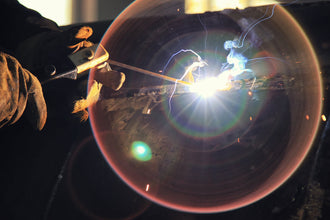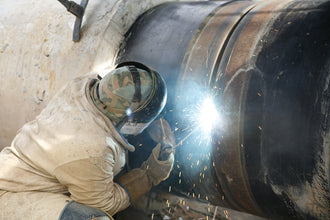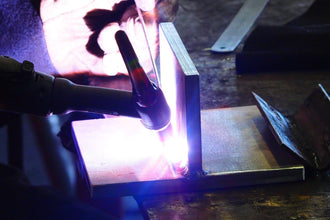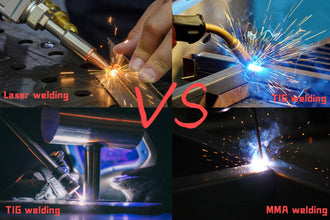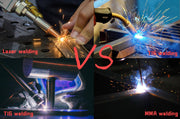
Introduction to Welding Technologies
Welding is the backbone of modern manufacturing, enabling the fabrication of everything from skyscrapers to microelectronics. Among the myriad welding techniques, arc welding and laser welding stand out for their versatility and precision. This guide dives deep into their differences, advantages, limitations, and industrial applications, empowering engineers and project managers to make informed decisions.
What is Arc Welding?
Definition and Core Principles
Arc welding is a process that uses an electric arc to melt and fuse metals. By generating temperatures up to 6,500°F (3,593°C), it creates a molten pool that solidifies into a strong joint. The arc forms between a consumable or non-consumable electrode and the workpiece, while shielding gas (e.g., argon, CO₂) protects the weld from atmospheric contamination.
Key Components of Arc Welding
-
Power Source: Delivers adjustable current (AC/DC).
-
Electrode: Conducts current and may act as filler material.
-
Shielding Gas: Prevents oxidation (e.g., MIG uses CO₂/argon blends).
Types of Arc Welding
1. Shielded Metal Arc Welding (SMAW)
Process: Uses a flux-coated electrode that decomposes into shielding gas.
Pros: Portable, works outdoors, no external gas required.
Cons: Slag removal needed, slower deposition rates.
Applications: Pipeline construction, repair work.
2. Gas Metal Arc Welding (GMAW/MIG)
Process: Continuous wire feed + inert gas shielding.
Pros: High speed, minimal cleanup, suits thin-to-thick metals.
Cons: Sensitive to wind, higher equipment costs.
Applications: Automotive manufacturing, structural steel.
3. Gas Tungsten Arc Welding (GTAW/TIG)
Process: Non-consumable tungsten electrode + separate filler rod.
Pros: Superior precision, clean welds, no spatter.
Cons: Requires skilled operators, slower than MIG.
Applications: Aerospace, nuclear reactors, artistic metalwork.
What is Laser Welding?
Definition and Core Principles
Laser welding employs a high-energy laser beam (e.g., fiber, CO₂, or Nd:YAG lasers) to melt and bond materials. The beam’s intensity (up to 10⁶ W/cm²) allows micron-level accuracy, making it ideal for delicate or automated tasks.
Key Components of Laser Welding
-
Laser Source: Generates the beam (fiber lasers dominate modern systems).
-
Optics: Focuses the beam to a precise spot (0.1–1 mm diameter).
-
Cooling System: Prevents overheating during prolonged use.
Types of Laser Welding
1. Conduction Welding
-
Process: Low-power beam melts surface layers without vaporization.
-
Pros: Minimal distortion, smooth finish.
-
Applications: Thin sheets (e.g., medical device housings).
2. Keyhole Welding
-
Process: High-power beam vaporizes metal, creating a deep cavity (keyhole).
-
Pros: Deep penetration (up to 25 mm), high-strength joints.
-
Applications: Automotive drivetrain components, shipbuilding.
Arc Welding vs. Laser Welding: Key Differences
Heat Input and Precision
Arc Welding
-
Heat-Affected Zone (HAZ): Wider due to diffuse heat spread.
-
Distortion Risk: High in thin materials (e.g., automotive panels).
Laser Welding
-
HAZ: Extremely narrow (<1 mm), reducing thermal stress.
-
Precision: ±0.1 mm accuracy for micro-welds (e.g., pacemaker components).
Speed and Efficiency
Arc Welding
-
Deposition Rate: 1–10 lbs/hour (varies by process).
-
Limitations: Manual processes slow down large-scale production.
Laser Welding
-
Speed: Up to 100 meters/minute for thin sheets.
-
Automation: Robotic arms + CNC systems enable 24/7 operation.
Material Compatibility
Arc Welding
-
Metals: Carbon steel, stainless steel, aluminum.
-
Challenges: Poor performance on reflective metals (e.g., copper).
Laser Welding
-
Metals: Steel, titanium, nickel alloys, and even plastics.
-
Dissimilar Materials: Bonds copper to aluminum (common in EV battery packs).
Pros and Cons of Arc Welding
Advantages of Arc Welding
-
Cost Efficiency
-
Equipment: Basic SMAW setups cost 2,000.
-
Training: Widely available certifications (e.g., AWS).
-
-
Versatility
-
Works in harsh environments (wind, rain) with SMAW.
-
Handles rusty or painted surfaces better than laser welding.
-
-
Thick Material Mastery
-
Welds >1-inch steel plates for bridges and ships.
-
Disadvantages of Arc Welding
-
Skill Dependency
-
TIG welding demands 200+ hours of practice for proficiency.
-
-
Post-Weld Labor
-
Slag chipping, grinding, and brushing add 15–30% to project time.
-
-
Energy Waste
-
Only 30–50% thermal efficiency due to heat loss.
-
Pros and Cons of Laser Welding
Advantages of Laser Welding
-
Surgical Precision
-
Welds 0.2 mm wires in electronics without damaging nearby components.
-
-
Speed and Automation
-
Automotive factories achieve 500 welds/hour with robotic laser cells.
-
-
Minimal Post-Processing
-
Near-net-shape welds reduce finishing costs by 40%.
-
Disadvantages of Laser Welding
-
High Capital Costs
-
Industrial fiber laser systems: 1 million.
-
-
Material Limitations
-
Reflectivity issues with copper and aluminum require infrared absorbers.
-
-
Safety Risks
-
Class 4 lasers demand enclosed work cells and protective eyewear.
-
Applications of Arc Welding vs. Laser Welding
Industrial Uses of Arc Welding
1. Construction and Infrastructure
-
Case Study: Golden Gate Bridge repairs used SMAW for rusted steel beams.
2. Oil and Gas Pipelines
-
Process: GMAW welds X80 steel pipes at 30–40 cm/minute.
3. Heavy Machinery
-
Example: CATERPILLAR uses submerged arc welding (SAW) for bulldozer frames.
Industrial Uses of Laser Welding
1. Automotive Manufacturing
-
EV Battery Packs: Laser-welded aluminum busbars ensure low resistance.
2. Medical Technology
-
Case Study: Stryker’s surgical tools use hermetic laser seals to prevent infections.
3. Consumer Electronics
-
Example: Apple’s MagSafe connectors employ micro-laser welding for durability.
Cost Comparison: Arc Welding vs. Laser Welding
Initial Investment
| Factor | Arc Welding | Laser Welding |
|---|---|---|
| Equipment Cost | 50,000 | 1,000,000+ |
| Setup Complexity | Low | High (requires optics calibration) |
Operational Expenses
| Factor | Arc Welding | Laser Welding |
|---|---|---|
| Consumables | Electrodes, gas | Laser diodes, lenses |
| Energy Use | 5–10 kWh | 10–50 kWh |
| Labor Costs | High (manual) | Low (automated) |
Future Trends in Welding Technologies
Hybrid Welding Systems
-
Laser-Arc Hybrid: Combines laser precision with arc welding’s gap-bridging ability (e.g., shipyard panel welding).
Green Welding Innovations
-
Arc Welding: Bio-degradable flux coatings reduce landfill waste.
-
Laser Welding: Solar-powered lasers cut carbon footprints by 25%.
Conclusion: Choosing Between Arc and Laser Welding
Arc welding remains indispensable for heavy, outdoor, or budget-conscious projects. In contrast, laser welding dominates high-precision, automated industries like EVs and medtech. By aligning your choice with material type, budget, and production scale, you can maximize ROI and product quality.
No matter what kind of welding machine you need, Doughty Welder can provide for your needs. Contact our sales team if you need advice beyond what this article provides. Our team of experts can help you make the right choice.
🧐🧐🧐You might like the following:
1.Select laser welding machine, product introduction: All You Need to Know
2. Quick Start Guide for the welding industry: A shortcut to mastering technology
3.Based on 4000+ customer reviews, this plate gold welding artifact stan




